The Harp

The Harp
 Travelling on a plane from Luxor to Cairo, Egypt, I was passing a cup of tea carefully across to the lady on my left. Falling into conversation with her, I discovered she was a musician who played and taught the harp in Cairo. She must have caught my look of surprise because I had always rather tended to think of harps as being played in drawing rooms in Regency England (or Bridgerton) by prospective brides happy to demonstrate their musical prowess.
She reminded me that harps were actually played in antiquity, at least since 3,000BC and that there are pictures of harps in the wall paintings of many Ancient Egypt tombs. The goddess Hathor was often depicted with a harp and she was associated with the sky, with women, love, drinking and music.
Travelling on a plane from Luxor to Cairo, Egypt, I was passing a cup of tea carefully across to the lady on my left. Falling into conversation with her, I discovered she was a musician who played and taught the harp in Cairo. She must have caught my look of surprise because I had always rather tended to think of harps as being played in drawing rooms in Regency England (or Bridgerton) by prospective brides happy to demonstrate their musical prowess.
She reminded me that harps were actually played in antiquity, at least since 3,000BC and that there are pictures of harps in the wall paintings of many Ancient Egypt tombs. The goddess Hathor was often depicted with a harp and she was associated with the sky, with women, love, drinking and music.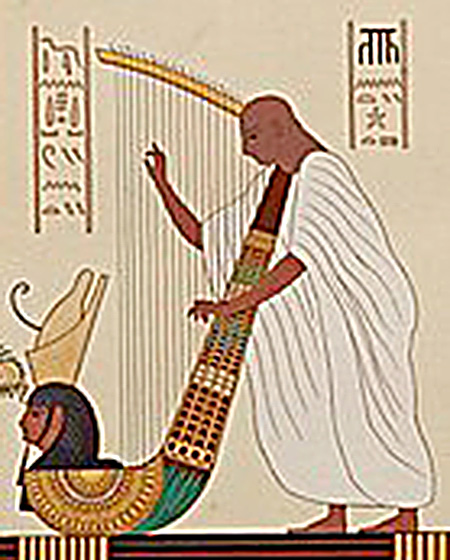 Indeed, the harp, which was called benet in ancient Egyptian, was one of the most popular musical instruments throughout pharaonic history.
Indeed, the harp, which was called benet in ancient Egyptian, was one of the most popular musical instruments throughout pharaonic history. 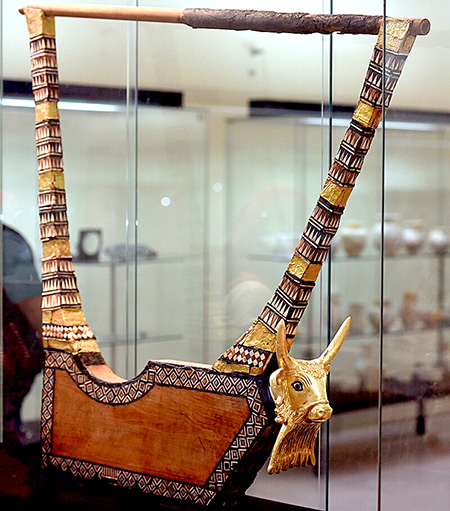 A bow harp is one of the oldest musical instruments to have survived, characterized by a long, curving neck and a shovel-shaped sound box. It would have originally been covered by parchment or animal skin and the sound box would have resonated when the instrument’s five strings were plucked.
Harps remain essentially triangular and are still made primarily of wood today.
A bow harp is one of the oldest musical instruments to have survived, characterized by a long, curving neck and a shovel-shaped sound box. It would have originally been covered by parchment or animal skin and the sound box would have resonated when the instrument’s five strings were plucked.
Harps remain essentially triangular and are still made primarily of wood today. 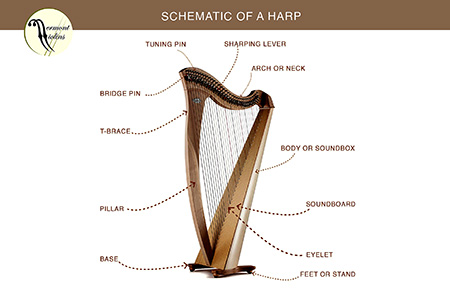 The distance between the tuning peg and the soundboard, as well as the tension and weight of each string, determines the pitch. The body is hollow, and when the string is plucked, the body resonates, projecting sound.
Harps were played by both men and women and it is clear the instrument was used as accompaniment for singing. The ancient Egyptian word for musician was hst (heset) and it is not dissimilar to the Old English hearpe which is akin to Old High German harpha that leads to the word harpsichord, albeit that instrument is very different from the harp and did not evolve until the Middle Ages.
Harps also have a long history in Britain. One is depicted on an 8th-century Pictish stone in Scotland[ which dates from around 800 AD. Christianity attributed celestial harps to angels giving the instrument associations of the sacred and heavenly.
The distance between the tuning peg and the soundboard, as well as the tension and weight of each string, determines the pitch. The body is hollow, and when the string is plucked, the body resonates, projecting sound.
Harps were played by both men and women and it is clear the instrument was used as accompaniment for singing. The ancient Egyptian word for musician was hst (heset) and it is not dissimilar to the Old English hearpe which is akin to Old High German harpha that leads to the word harpsichord, albeit that instrument is very different from the harp and did not evolve until the Middle Ages.
Harps also have a long history in Britain. One is depicted on an 8th-century Pictish stone in Scotland[ which dates from around 800 AD. Christianity attributed celestial harps to angels giving the instrument associations of the sacred and heavenly.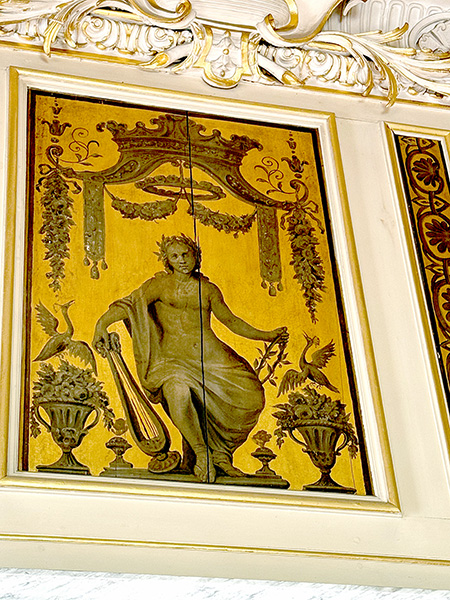 Today, it is a less fashionable musical instrument. The shape has evolved to incorporate the "pillar", a third structural member to support the far ends of the arch and soundbox. The concert harp is an even more technologically advanced instrument, distinguished by its use of pedals, (foot-controlled levers) which can alter the pitch of given strings, making it chromatic and thus able to play a wide body of classical repertoire whether alone or in ensembles with singers and other musicians.
Today, it is a less fashionable musical instrument. The shape has evolved to incorporate the "pillar", a third structural member to support the far ends of the arch and soundbox. The concert harp is an even more technologically advanced instrument, distinguished by its use of pedals, (foot-controlled levers) which can alter the pitch of given strings, making it chromatic and thus able to play a wide body of classical repertoire whether alone or in ensembles with singers and other musicians.
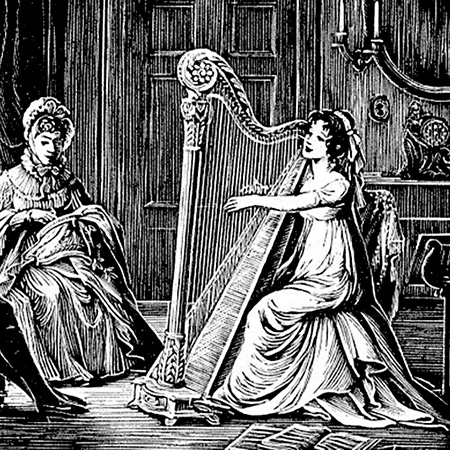 The painted ceiling of the Music Room at Highclere is dedicated to the wisdom of the Roman goddess Minerva. Ancient Greece and Rome both had many representations of ladies playing harps (or Lyres) shown on vase paintings dating from as far back as 400 BC but on the whole the lyre was much more popular in both cultures. Nevertheless, there is a rather romantic depiction of a classical musician on the gilded doors in the room.
Harps became popular in the drawing rooms of grand homes and young girls such the harp-playing Mary Crawford in Mansfield Park would have entertained the assembled party with lilting repertoires.
Not far from Highclere, at Chawton in Hampshire, a 250-year-old harp that was once owned by Jane Austen’s cousin Eliza has been restored and i
The painted ceiling of the Music Room at Highclere is dedicated to the wisdom of the Roman goddess Minerva. Ancient Greece and Rome both had many representations of ladies playing harps (or Lyres) shown on vase paintings dating from as far back as 400 BC but on the whole the lyre was much more popular in both cultures. Nevertheless, there is a rather romantic depiction of a classical musician on the gilded doors in the room.
Harps became popular in the drawing rooms of grand homes and young girls such the harp-playing Mary Crawford in Mansfield Park would have entertained the assembled party with lilting repertoires.
Not far from Highclere, at Chawton in Hampshire, a 250-year-old harp that was once owned by Jane Austen’s cousin Eliza has been restored and i t plays differently from a harp of today with a very bright, silvery sound but is a gentler instrument designed to be to be played in a salon at home.
We still occasionally ask a harpist, Tory Hands - a much-lauded classical musician, to play at some events at Highclere. Music seems to reach inside our minds in such a different way to almost anything else and always adds an extra dimension to any evening.
“Life seems to go on without effort when I am filled with music.” (George Eliot)
t plays differently from a harp of today with a very bright, silvery sound but is a gentler instrument designed to be to be played in a salon at home.
We still occasionally ask a harpist, Tory Hands - a much-lauded classical musician, to play at some events at Highclere. Music seems to reach inside our minds in such a different way to almost anything else and always adds an extra dimension to any evening.
“Life seems to go on without effort when I am filled with music.” (George Eliot)
36 Comments
Going to Egypt in a few months time. My daughter is an archaeologist who has done much work in the western desert. I am not surprised that the harp was present in Egypt. Did not the bagpipes in another form found its earliest form in Egypt? Few civilizations have a history that spans so many thousands of years. I will get to visit Tutankhamun's burial place as it is open to tours and I will be traveling on the Osiris with Viking. I have visited Highclere and seen the exhibit there so this is a dream come true.
Jonathan, I hope you have a wonderful time aboard Osiris, I've no doubt you will.
I am not a musician, nor am I familiar with musical history, but I always thought the structure of the piano and harpsichord were similar to a harp laid on its side! A harpsichord is plucked, as is a harp.
Very lovely article Lady C! We will be going to Highclere next spring. I hope to see you there!
An oft-quoted, but potentially dubious "historical statement" exists that in January 1603 Queen Elizabeth decreed that all Irish harp players should be hung and their harps burned. That may or may not be true.
However, there exists bona fide evidence that on 20 January 1603, the Lord President and Council of Munster issued an Edict that required the Marshall of that Province to “execute by martial law in and throughout the whole province of Munster all Idle men, sturdie beggers, vagabonds, harpers, Rhymers, bardes” who were found travelling or residing in the province who could not produce a letter or bill under his master’s hand or a licence or passport of his Captain or known Marshall Officer to testify whose servant he was.
Another version of the Edict dated 27 January gives a slightly different list of vagabonds: “...all manner of Bardes, rymers, harpers, Stokeghes [young men(?)], Clubbuers [(vagrants(?)] and all manner of vagrant and maisterles persons...” Nevertheless, "Harpers" were specifically named as "vagabonds" in each Edict.
Notwithstanding the above, I have always been fascinated by the harp. Its shape, sound and even the way it is positioned when played, have always delighted my aural and visual senses. I think that my fascination for this instrument began from watching way too many Marx Brothers movies in my infant years. Although he had his limitations as a harpist (which he readily acknowledged) I have read that Harpo Marx is widely regarded as "one of the greatest and most influential harpists who ever lived".
Dear Lady Carnarvon,
Thank you for continuing to educate us with your eloquent essays of history!
Carolyn, Temecula CA
Dear Lady Carnarvon,
Thank you for your research and thoughtful commentary on this very beautiful instrument. Even here in downtown Chicago we are occasionally treated to a harpist performing during a High Tea. We musicians offer this bit of humor, that harpists spend half their time tuning their instruments...and the other half playing out of tune. Just a smile intended, and no aspersions cast upon players of a very difficult instrument!
Signed,
A Music Lover
I had a harp at our wedding. It was a first for most of the guests. They loved it and appreciated being able to talk without being drowned out by a loud band. It was nice, and adds elegance and dignity to an event. Not every has to have it raucous!
Thank you for another interesting account.
Many thanks for yet another interesting & educational way to start the day, Lady Carnarvon.
I wish you both a Happy Thanksgiving & a Merry Christmas.
Thanks again for coming to Williamsburg & having devotees from Virginia for lunch. Wonderful memories!
Warm regards, Sylvia Payne
Lovely the music of the harp and did you and lord Carnarvon have a wonderful weekend and l am fan of Downton Abbey and lovely highcelere castle
I am so glad to see you write about harps. My granddaughter and myself have played the harp, its quite an instrument to accomplish. Our teacher took us through a certified program from the Royal Academy of Music in London. We would move through levels of music and then travel to an auditor that would asses us. It is a very good program and a bit nerve racking. But we were taught very well. Before each rehearsal, 47 strings must be tuned. It is an instrument of dedication to say the least.
Thank you again for the good history and information. I love that you wrote about this.
Debbie
Lady Carnarvon,
Thank you for this interesting blog on the beautiful harp. I agree with the words of George Eliot. without music life would be impossible.
I love "harp" music.
In my little corner of the world , many people attend an annual church service for the first Sunday of Advent , where a harpist and his harp play a leading role in the music.
Thank you for your blog on "the harp".
Wendy
Never too old to learn! Thank you for this Music- and history-lesson.
Do you play any musicinstrument yourself?
Thank you Henk, yes I play the piano. Quite often I sit in the drawing room in the evening and play as I find it immensely relaxing.
Another fascinating & historic Monday Morning Blog Lady Carnarvon. I will also be sharing this information with a cousin of mine who has been a harpest for 45 years and is still performing on her own and with orchestras & bands throughout Michigan and sometimes Ohio, Pennsylvania & Chicago, Illinois, so many like her performance and sounds of her harps. Thank you again for another educational Blog and with lovely photos.
The harp is mentioned throughout the Old Testament of the Bible. Reading the Bible as a collection of historical documents is quite interesting.
I also enjoy the Old Testament.
Lovely the harp and wish you and lord Carnarvon a happy Christmas and lam a fan of Downton Abbey and lovely highcelere castle and happy Christmas to your staff at highcelere castle
I love the sound of harps and often listen to this type of music to relax. Thank you for the enjoyable and informative story.
It is interesting to think of the ancient gatherings in Egypt accompanied by harp music! That is definitely a different spin on things! Many thanks for an entertaining and educational post.
A wonderful, informative blog! Thank you, Lady Carnarvon I found myself thinking about the 1930’s entertainer Harpo Marx and how he would be absolutely maniacal with his comedy and sit down at his harp, playing so beautifully. His playing would give visions of waterfalls and such. An incredible instrument!
Dear Lady Carnarvon,
Thank you for your lovely notes about the harp. I used to be a classical opera singer and now that I am over 65 I decided to stop singing and am now currently learning the concert harp from the very beginning. I decided if I make mistakes (which is more than inevitable) I wouldn’t mind making them on a harp that creates such gorgeous sounds!
All the best,
Claudia Fisher
Well done you for learning a new skill - what a beautiful instrument to learn
On a trip to Ireland one October, I was determined to buy an Irish harp. My husband and I went to a music store, selected the perfect harp, and proceeded to plunk down our credit card for payment and shipping back to the United States. The lovely young sales lady told us that she felt honor bound to let us know that the harp had been made in the United States, in fact, in our own home state of Kentucky! Needless to say, we did not buy it and thanked her for her honesty and integrity. I thought that was the end of it, until Christmas morning when I was surprised by a harp sitting next to the tree. My husband had visited the maker right here in town, and so I got my Kentucky made Irish harp after all!
What a lovely story
Lovely post. I’m 75 and have played violin since aged 7. I still play in a community orchestra (with players aged from 20 to 90), and there has always been a harpist in the group. My brother played the harp also. Christmas greetings from Australia.
As a musician I was pleased that you focused on an instrument and its history for your blog, yet still bringing a relationship to Highclere into your discussion. Some of the comments were delightful; you have a very erudite following!
Dear Lady Carnarvon,
Your article today reminds me of the power of music. Many Hospice chaplains can speak about the calming effect of harp music on their patients. I'm currently reading, "Mind and Music," curated by opera star, Renee Fleming, a collection of essays by scientists, doctors, and musicians of every stripe about the healing power of music. Her friend and colleague, Leontyne Price who is in her 90's sings every day and can still reach high C. What a role model.
Sincerely,
Carol Giantonio
Eugene, Oregon USA
Herewith follows an historical (hopefully, of some interest) addition to the above remarks.
The Met in New York has an Egyptian bow harp on display that the museum dates back to 2030–1640 B.C. The Met describes the instrument on display, as follows:
“The harp, called “benet” in ancient Egyptian, was one of the most popular musical instruments throughout pharaonic history. This bow harp, among the oldest to have survived, is characterized by a long, curving neck and a shovel-shaped sound box. Originally covered by parchment or animal skin, the sound box would have resonated when the instrument’s five strings were plucked. Harpers played either alone or in ensembles with singers and other musicians.”
Of course, the Met houses many other harps including a shoulder harp (1390–1295 B.C., also of ancient Egyptian origin) to the classic 1929 ‘Lyon and Healy’ Harp.
It may be of interest to “history trivia buffs” to learn that the latter (1929) harp at the Met was originally purchased by Evangeline Booth, who interestingly was the fourth (and first woman) General of the Salvation Army.
Possibly one of the greatest classical harpists of all time, Mildred Dilling, purchased that harp from Ms Booth. (Dilling reportedly owned a large collection of harps numbering more than 65 at the time of her death.). By the way, Dilling recorded with artists including Bing Crosby. She also was the teacher of Harpo Marx.
My sister is a harpist and sent me this lovely post which reminded me to sign up again for your Monday essays. Thank you for taking the time to give us a bit of a history lesson with this ancient and oh so pretty instrument.
In my role as Pastoral Counselor in Palliative Care we use what is called a reverie harp which is designed for people to hold and just strum the strings, which aids their relaxation and aids in helping to alleviate their anxiety.
And today, a number of harps are manufactured right here in Chicago, by Lyon and Healy; and lets not forget that VERY gifted artist - Harpo Marx!
Thank you for your blog on harps and Egypt Lady Carnarvon. I was lucky enough to attend a concert recently in San Angelo that was from a new piece of music by Ben Forrest called Creation. Besides an orchestra from Angelo State university in San Angelo, there were 5 choirs, including a handbell choir, and 4 soloists and also a harp. The work is in 27 different movements about the Old Testament and was the third time the work had been performed anywhere. The number of musicians meant the stage had to be rebuilt to contain them all.
And yet a harp is also sometimes part of a chamber orchestra as well. Lovely instrument. And still I am happy with my piano, as I expect you are yours.
Your writing matches your musical ability perfectly. Have a good week.
Mary L. Mantel
(Catholic accompanist at Goodfellow AFB chapel,
San Angelo TX).
The harp often reminds me of angelic music which sounds so comforting. Music on the harp has evolved to modern sounds but I still appreciate the classical harp music more. Your family's ties to Egypt, again, is so intriguing. I think I saw a harp in one of the museums in Cairo. My congratulations to your son for being named Godfather of one of the new Nile river cruise ships. He must of enjoyed the balloon ride with your husband. Seeing pictures of his journey brought back wonderful memories of my balloon ride there.
It was a wonderful adventure for the family and one we won't forget.
35 years ago I visited San Gimignano in Tuscany. In one of the courtyards a musician was playing the harp - it was such an enchanting moment. Thank you for bringing back this wonderful memory by yout words!
Dearest Lady Carnarvon,
Your stellar article on the harp was most appreciated. I was unfortunately laid up for five months in the ICU at The Baptist Hospital in SC. There were a series of days when I wasn’t sure I was yet on this earth and on such a one, I woke and sat straight up in the bed which startled my assigned nurse. What woke me? The very near and striking sound of full blown HARP music I was quite sure I had finally succumbed to my vast injuries only to be reassured that the musician was playing for the gentleman next door. For the remainder of my time there this lovely young lady came twice a week to play for me. It is one of the hospital’s many patient outreach programs. It has been proven that much less pain medication is necessary throughout ICU whenever she plays. The proven power of that harpist!
Music can have such healing powers
Thank you Lady Carnarvon for sharing your experience.
The bagpipes also have a history particularly with the Indian Sub-continent.
If fact, even today, bagpipes are still being produced in Pakistan for export all over the world.
The Pan pipes are also another very ancient musical instrument with origins maybe in Greece or maybe South America.
The Harp, no doubt is a beautiful instrument.
Best wishes and stay warm.
Angela
Thanks as always for such an enlightening piece of information. In the next few months will be travelling to the country of Egypt for about a month (and to the Middle and Far East) and will spend time doing personal research (there and in the Holy Land) on the Holy Bible and the Holy Quran. I may not be as in-depth where etymology is concerned in comparison to your in-depth library of knowledge and an always grateful to learn more on topics such as these. You are appreciated!
Dear Lady Carnarvon:
Thank you for this prior Monday's blog. I enjoyed reading about your encounter with your flight's seat mate and the musical history of the harp you have presented.
Perpetua Crawford
Leave a Comment

- Christmas
- Community
- Dogs & Horses
- Egypt & Tutankhamun
- Entertaining
- Farm
- Filming
- Gardens
- History & Heritage
- Daily Life
- Royalty
- Cooking
- Interiors
- Heroes
- Architecture
- Cars
- Conservation
- Downton Abbey
- Events
- Gardens & Landscape
- Highclere Castle Gin
- History
- Planes
- Restoration
- Stories & Books
- Uncategorized
- Visitors
- Wildlife





The word H AR P has in the centre RA.Name of Egyptian sun god
H is breath of life and P is outreaching.
R is intense external energy,like a sun and A is our perceived reality.
Am I harping on a bit ?
Graham
Thank you Graham, very amusing.
Fascinating comment Graham I love the knowledge and of course your playful sense of humor. Thank you for sharing. Regards, Corinne
You have done it again, Lady C! Learning is my passion. You teach us so much. Last Monday I had to pull a book off the shelf and reread and study a favorite T.S. Eliot poem. Today I am searching for harpists! And, oh my, the George Eliot quote! I have memorized this treasure as it expresses so perfectly how I feel about music! I must have music, as I must have breath, food, water, and umm, er uh....also the internet. You have made it a necessity!
Thank you, thank you so very much.